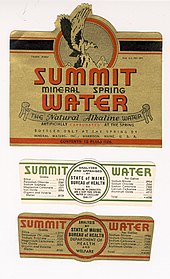label
A label (of French etiquetter from estiquier , pinning ', originally. List with instructions in Spanish court ceremonial , Swiss and Austrian etiquette ) is a sign on or to the packaging of a product or the product itself. It is sometimes instead of the word label and label ( English for note , label ) used.
history
The Economic Encyclopedia of 1858 contains the following statement: "Etiquette (are) for merchants and traders a piece of paper or parchment which is attached to an object in order to remember its price or its quality." Furthermore, it is stated that "... the pharmacists ... also glue such labels or notes onto the jars, tins and boxes to distinguish the drugs they contain and for the sake of memory."
Labels are important evidence and evidence of the history of trade and the creation of branded goods .
function
The label can contain information about the content, price , address , best-before date , transport and hazard information and instructions for use such as B. contain textile care symbols . On branded items , the label is also an advertising medium with information about the brand . A special form is the article security label , which is used in retail as a measure to prevent theft.
Various labeling methods are used in production to apply the label . Self-adhesive stickers are known as adhesive labels .
Long-lasting adhesive labels with uniform typefaces (for example to identify electrical lines, switches or fuses) are possible with DYMO embossed labels. An adjustable type wheel contains stamps with which a (self-adhesive) plastic tape can be individually embossed at the location of the marking.
Use obligation
Numerous laws and regulations in Germany expressly stipulate the use of labels as consumer protection . B. for wine in Section 47 of the Wine Ordinance , for seeds in Section 29 of the Seed Ordinance , for textiles in Section 9 of the Textile Labeling Act .
See also
Further meaning
In a figurative sense, the term label is used to assign certain terms, groups, facts, etc. to a common short name that is associated with positive or negative associations . One example is the labeling of individual persons, parties or organizations in politics as “left” or “right”. Labeling in this sense easily leads to a simplification of more complex backgrounds and to the formation of prejudice or stigmatization .
Web links
- Labels - information from the Federal Office for the Environment
Individual evidence
- ↑ Economic Encyclopedia online: Etiquette .
- ↑ Christa Pieske: ABC of luxury paper, production, distribution and use 1860–1930. Museum for German Folklore, Berlin 1983, ISBN 3-88609-123-6 , pp. 115–122.



